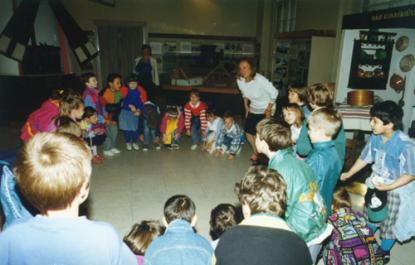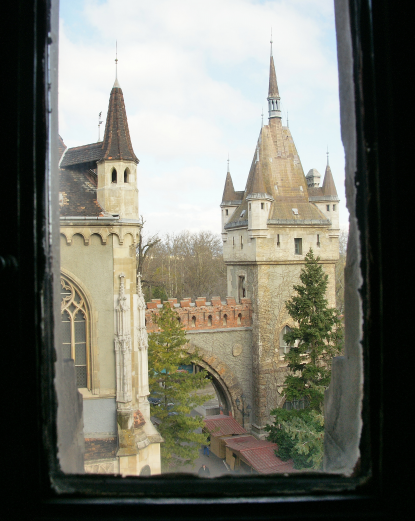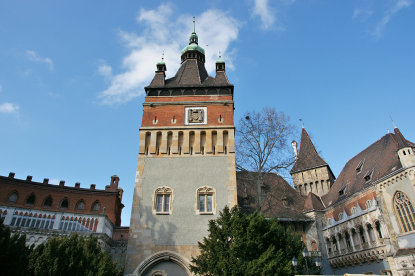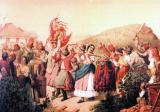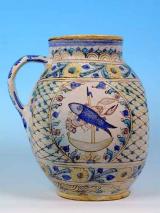2025. July 15. Tuesday
Museum and Library of Hungarian Agriculture - Budapest
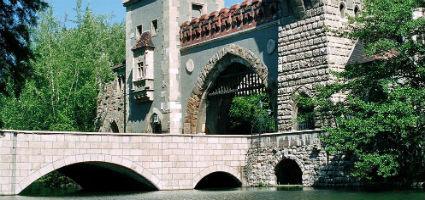 |
Address: 1146, Budapest Városliget, Vajdahunyadvár
Phone number: (1) 363-1117
E-mail: info@mmgm.hu
Opening hours: 01.03-31.10.: Tue-Sun 10-17
01.11-28.02.: Tue-Fri 10-16, Sat-Sun 10-17 |
The end of the 19th century brought a unique anniversary for the Hungarian nation. A thousand years before the Original Settlement took place, Jenő Zichy, president of the National Trade Association, proposed an Expo and a program series for the anniversary. By 1893, the plan of a large millennial exhibition began to unfold. The planned economic and industrial exhibitions were to focus on the thousand-year history of Hungary. The year of the celebration was to be 1896.
An application was announced for the building of the millennium exhibition on 8, February, 1893. 11 plans were sent in by 30, April. The characteristic part of the application was the actuality that almost all the applicants chose the Széchenyi Island as location for the exhibition. The jury raised objections against all of them. The best applicants, Ignác Alpár, Albert Schickedanz , and Ferenc Pfaff were asked to send in new plans.
At last, the jury made a strange decision. The plan of Ignác Alpár was declared the winner, but they jury stated that the architect would not be able to solve the task since the building was too large. Nevertheless, if the building could still be built it would look like an unsuccessful mixture. The minister still commissioned the work to Ignác Alpár setting the deadline in four months.
The building system was divided into three parts: the period of the kings of the House of Árpád - Roman style; the period of the kings from different families-gothic, the period of the Habsburg family-renaissance and baroque style.
The construction works began on the summer of 1894. Since everything was built for the short term and fast, first the wooden structure of the walls were raised that were later filled with bricks.
The building set constructed on a 4580 m2 area of 593.000 forints was ready by the end of 1895. The organization of the exhibitions could be started. The building was the location of the exhibition presenting significant periods and events of the thousand-year history of Hungary. In the wing built in Roman style a resting place was formed for Franz Joseph and his suite.
The Millennium exhibition was opened on 2, May 1896 with the presence of the emperor. In half a year, thousands of visitors saw the showing. The building set designed by Alpár became extremely popular. Since the most characteristic part of the building modeled the Vajdahunyad Castle in Transylvania, the creation of Alpár was called Vajdahunyad Castle even at that time.
After the exhibition closed, the 900 owners took back the 14.000 pieces formerly exhibited. After the buildings were renovated, the Hungarian Royal Agricultural Museum obtained them. However, the history of the building was not over.
By 1899 the Gothic wind, by the middle of the year the Renaissance wing sunk and began to crack. The building that became so popular at the time of the exhibition had to be taken down. Thus, Ignác Alpár was commissioned again to construct the new building.
Ignác Alpár changed a little of his original plans. The arrangement stayed the same but in between the gothic and renaissance groups he planned a new building to host the mechanical apparatus. New buildings took up the yard of the Renaissance building.
At least the buildings were opened in June 1907 as the new home of the Hungarian Royal Agricultural Museum. The construction works were not finished yet. Many of the plans concerning interior design of Alpár were only fulfilled after decades.
The Vajdahunyad Castle was declared a national monument in 1991.
An application was announced for the building of the millennium exhibition on 8, February, 1893. 11 plans were sent in by 30, April. The characteristic part of the application was the actuality that almost all the applicants chose the Széchenyi Island as location for the exhibition. The jury raised objections against all of them. The best applicants, Ignác Alpár, Albert Schickedanz , and Ferenc Pfaff were asked to send in new plans.
At last, the jury made a strange decision. The plan of Ignác Alpár was declared the winner, but they jury stated that the architect would not be able to solve the task since the building was too large. Nevertheless, if the building could still be built it would look like an unsuccessful mixture. The minister still commissioned the work to Ignác Alpár setting the deadline in four months.
The building system was divided into three parts: the period of the kings of the House of Árpád - Roman style; the period of the kings from different families-gothic, the period of the Habsburg family-renaissance and baroque style.
The construction works began on the summer of 1894. Since everything was built for the short term and fast, first the wooden structure of the walls were raised that were later filled with bricks.
The building set constructed on a 4580 m2 area of 593.000 forints was ready by the end of 1895. The organization of the exhibitions could be started. The building was the location of the exhibition presenting significant periods and events of the thousand-year history of Hungary. In the wing built in Roman style a resting place was formed for Franz Joseph and his suite.
The Millennium exhibition was opened on 2, May 1896 with the presence of the emperor. In half a year, thousands of visitors saw the showing. The building set designed by Alpár became extremely popular. Since the most characteristic part of the building modeled the Vajdahunyad Castle in Transylvania, the creation of Alpár was called Vajdahunyad Castle even at that time.
After the exhibition closed, the 900 owners took back the 14.000 pieces formerly exhibited. After the buildings were renovated, the Hungarian Royal Agricultural Museum obtained them. However, the history of the building was not over.
By 1899 the Gothic wind, by the middle of the year the Renaissance wing sunk and began to crack. The building that became so popular at the time of the exhibition had to be taken down. Thus, Ignác Alpár was commissioned again to construct the new building.
Ignác Alpár changed a little of his original plans. The arrangement stayed the same but in between the gothic and renaissance groups he planned a new building to host the mechanical apparatus. New buildings took up the yard of the Renaissance building.
At least the buildings were opened in June 1907 as the new home of the Hungarian Royal Agricultural Museum. The construction works were not finished yet. Many of the plans concerning interior design of Alpár were only fulfilled after decades.
The Vajdahunyad Castle was declared a national monument in 1991.
